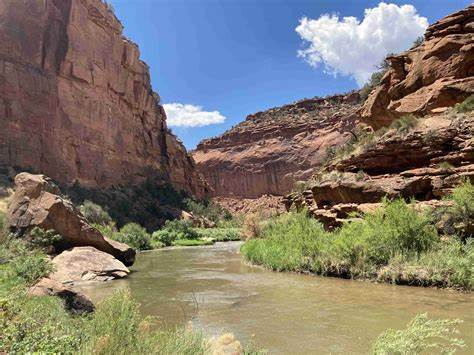The Sentinel’s Dennis Webb wrote an excellent and thorough article a few weeks ago about the effort to protect Dolores Canyons, including proposals for a national monument, a national conservation area, and several other options. As he chronicled, opinions are almost as varied as the communities potentially affected.
One Nucla resident who opposes the monument worries about the increased tourism such a designation would bring, saying “it would threaten the very solitude that makes the river corridor region special.” And although on the other side of the political issue, Grand Junction’s mayor talked similarly about the peaceful isolation of the area and its value for recreation. Both sides seem to share that love of one of Colorado’s most picturesque places.
So why the controversy? Why do some people think the area is so threatened that additional federal protection is urgent? After all the area is already, by definition, “protected” – almost all of it is public land, and there is no urban sprawl in Slick Rock, Bedrock, or Gateway. So, for people who value isolation, peacefulness, and a calming escape from a noisy world, what exactly is the threat from which Dolores Canyons must be protected?
Whatever monument proponents may say, the perceived threat is from one thing, and one thing only – mining. That’s because the region contains America’s foremost potential supply of uranium, vanadium, and several related minerals. That matters because public support for nuclear energy is growing as governments commit to decarbonizing their economies. According to the Pew Research Center, public support for nuclear energy rose to 49 percent by 2019, then declined to 43 percent when oil production spiked and made the U.S. energy-independent in 2020. But since the current Administration reversed that trend, a clear majority of Americans again want nuclear energy to be part of the solution – now 56 percent.
That in turn has heightened public awareness of critical supply chain issues, as it becomes increasingly clear that America does not produce the minerals necessary for a complete shift from fossil fuels. National Mining Association CEO Rich Nolan explains that “As the world begins the pivot towards fully electrified economies… our production of many of the metals essential to batteries, wind turbines, and solar panels is only a fraction of what it should be.”
That is not because the U.S. lacks critical minerals. It is because Americans have decided not to use their own domestic resources, but to depend instead on China and other countries. That is a political decision which should be revisited periodically. Nolan opines, “If we’re going to win the global energy and electrification race, we must start mining.”
Activists who disagree, and are comfortable with our dependence on China, have long sought to lock up the resources that could reverse this unhealthy economic equation. The Dolores Canyons region is part of that larger discussion, and while reasonable people may reach different conclusions, it is worth a serious and honest debate.
The proposed national monument covers most of the Uravan Mineral Belt, which includes the richest uranium and vanadium deposits in the country. From the end of WWII through the early 1970s that region produced 11 percent of the U.S.’s uranium supply (most of the rest came from Peru) and 80 percent of its vanadium. It was once the world’s largest source of radium, as well. There are over 500 historical mines, 600 mine prospects, and 965 active mining claims within the proposed monument boundaries – over 22,000 mining claims have been filed there since 1975. A national monument designation would end any further exploration, and while supporters promise valid existing claims would be honored, the deck is overwhelmingly stacked against development of new mines anywhere.
That is a worldwide supply chain problem, not unique to the United States. In fact, an S&P Global report found that it takes an average of 29 years to build a new mine in the U.S. (second-longest in the world), with similar lengthy delays in Canada, Argentina, Mongolia, and almost all other major mining countries. In Zambia, rich in copper and cobalt, it takes 34 years. Is it any wonder China is now the top supplier for 30 of the 50 minerals the U.S. government lists as essential for economic and national security?
Today nuclear power supplies only eight percent of U.S. energy. I don’t know whether that will increase. But if Americans at least want to preserve that option, it might not be wise to begin by locking away their largest supply of the minerals it might require.





Comments on this entry are closed.